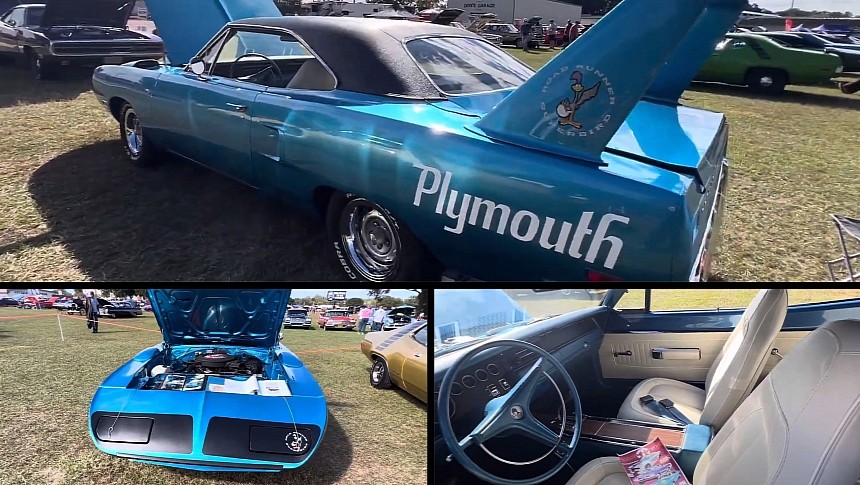The late 1960s and early 1970s gave us some of the most amazing American rigs. The horsepower wars were in full swing, and the Big Three were rolling out 400+ horsepower muscle cars like it was nobody's business.
Ford had beefed-up Mustangs and Fairlanes, and Chevrolet offered big-power Camaros, Corvettes, and Chevelles. Pontiac, Buick, and Oldsmobile had their own midsize goodness going. Dodge and Plymouth didn't fall behind either, thanks to nameplates like the Charger, Challenger, Super Bee, Road Runner, and Barracuda.
But the muscle car era also brought more experimental cars into showrooms. I'm talking about homologation specials that were essentially race-ready production models. But while Ford and GM rolled out more down-to-earth vehicles like the Mustang Boss 429 and the COPO Camaro ZL-1, Mopar went all-in with a pair of high-winged, sharp-nosed rigs.
I'm obviously talking about the "winged warriors" Chrysler developed for NASCAR racing. The Dodge Charger Daytona was the first radical muscle car that took the market by storm in 1969. Chrysler made 503 cars equipped with the 440-cubic-inch (7.2-liter) Magnum and the 426-cubic-inch (7.0-liter) HEMI V8s. Sold in just 70 units, the HEMI Daytona is now a million-dollar collectible.
Plymouth introduced its own "winged warrior" the following year. The Superbird was nearly identical to the Charger Daytona regarding equipment and firepower. However, Plymouth produced notably more cars. Actual figures remain a mystery, but most experts agree that Chrysler sold 1,935 examples in the US and nearly 50 in Canada. That's just under 2,000 cars, almost four times more than the Daytona.
Not surprisingly, the Superbird is thus more common and not as desirable as the Daytona. The HEMI models, on the other hand, also change hands for more than $1 million in unrestored and all-original conditions. But as this B5 Blue example shows, a Superbird doesn't need a 426 HEMI mill to stand out.
Spotted at the 2023 Mopars with Big Daddy show, this winged Mopar is as clean as they get, thanks to a frame-off restoration. And while it's not finished in a High-Impact color, the B5 Blue looks spectacular in the sun. Not only that, but this Superbird also rocks a white interior. As much as I love Plymouths in Moulin Rouge and Curious Yellow, nothing beats B5 Blue over white. It's the perfect combo, especially when the rear fenders flex large "Plymouth" lettering in white.
The super clean engine bay is home to a 440 Magnum V8. Or Super Commando, as Plymouth called the RB-block mill at the time. This unit appears to be the entry-level version, rated at 375 horsepower. Plymouth also offered a Six-Pack variant good for 390 horses, and both slotted below the 425-horsepower HEMI.
Granted, this Superbird may not be worth as much as a HEMI, but it's a highly documented gem that comes with a big pile of original paperwork. And that's precisely what you want to see in a golden-era classic. If you're not hooked on HEMI powerplants, it really doesn't get better than this.
But the muscle car era also brought more experimental cars into showrooms. I'm talking about homologation specials that were essentially race-ready production models. But while Ford and GM rolled out more down-to-earth vehicles like the Mustang Boss 429 and the COPO Camaro ZL-1, Mopar went all-in with a pair of high-winged, sharp-nosed rigs.
I'm obviously talking about the "winged warriors" Chrysler developed for NASCAR racing. The Dodge Charger Daytona was the first radical muscle car that took the market by storm in 1969. Chrysler made 503 cars equipped with the 440-cubic-inch (7.2-liter) Magnum and the 426-cubic-inch (7.0-liter) HEMI V8s. Sold in just 70 units, the HEMI Daytona is now a million-dollar collectible.
Plymouth introduced its own "winged warrior" the following year. The Superbird was nearly identical to the Charger Daytona regarding equipment and firepower. However, Plymouth produced notably more cars. Actual figures remain a mystery, but most experts agree that Chrysler sold 1,935 examples in the US and nearly 50 in Canada. That's just under 2,000 cars, almost four times more than the Daytona.
Not surprisingly, the Superbird is thus more common and not as desirable as the Daytona. The HEMI models, on the other hand, also change hands for more than $1 million in unrestored and all-original conditions. But as this B5 Blue example shows, a Superbird doesn't need a 426 HEMI mill to stand out.
Spotted at the 2023 Mopars with Big Daddy show, this winged Mopar is as clean as they get, thanks to a frame-off restoration. And while it's not finished in a High-Impact color, the B5 Blue looks spectacular in the sun. Not only that, but this Superbird also rocks a white interior. As much as I love Plymouths in Moulin Rouge and Curious Yellow, nothing beats B5 Blue over white. It's the perfect combo, especially when the rear fenders flex large "Plymouth" lettering in white.
The super clean engine bay is home to a 440 Magnum V8. Or Super Commando, as Plymouth called the RB-block mill at the time. This unit appears to be the entry-level version, rated at 375 horsepower. Plymouth also offered a Six-Pack variant good for 390 horses, and both slotted below the 425-horsepower HEMI.
Granted, this Superbird may not be worth as much as a HEMI, but it's a highly documented gem that comes with a big pile of original paperwork. And that's precisely what you want to see in a golden-era classic. If you're not hooked on HEMI powerplants, it really doesn't get better than this.











